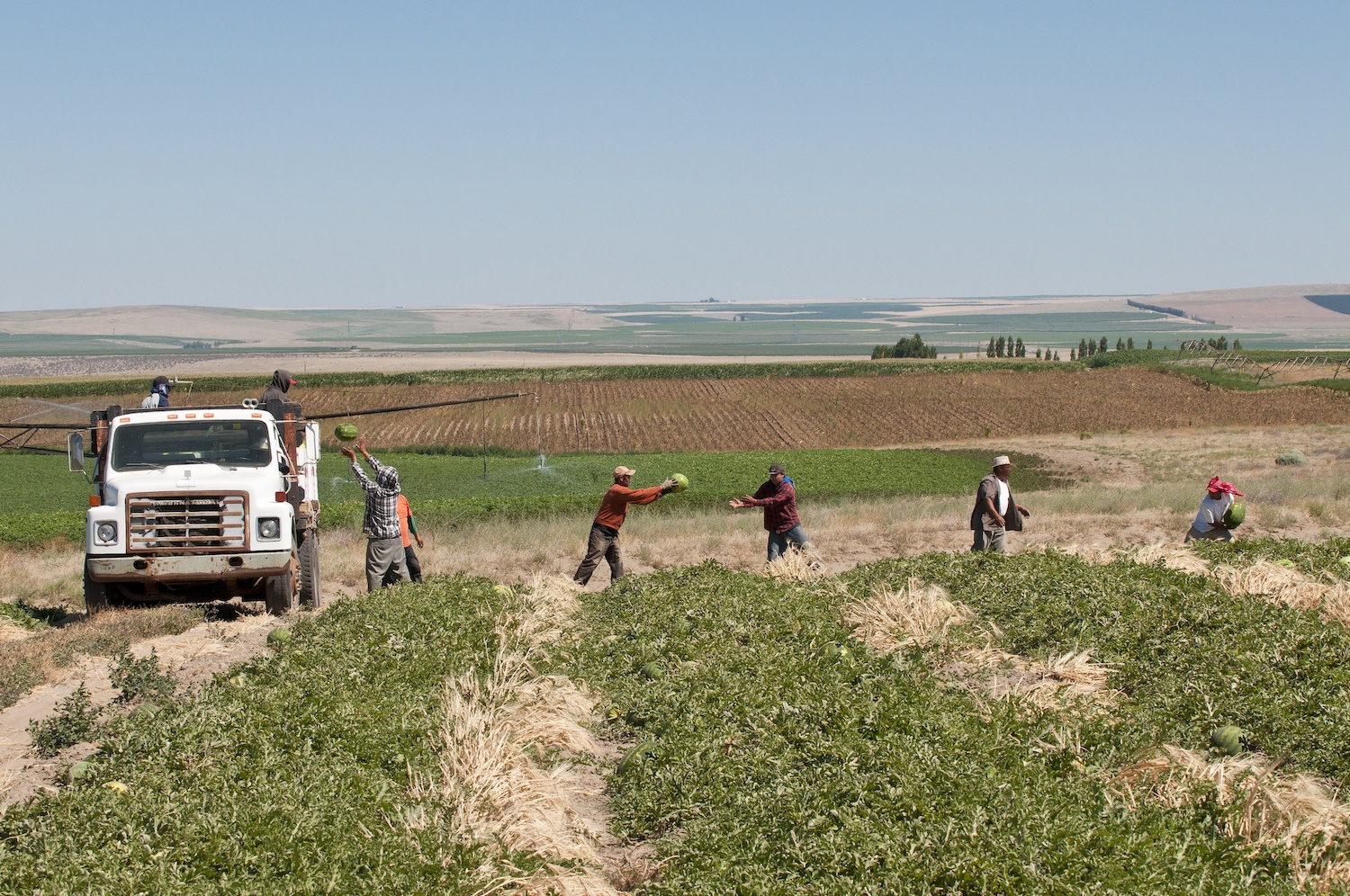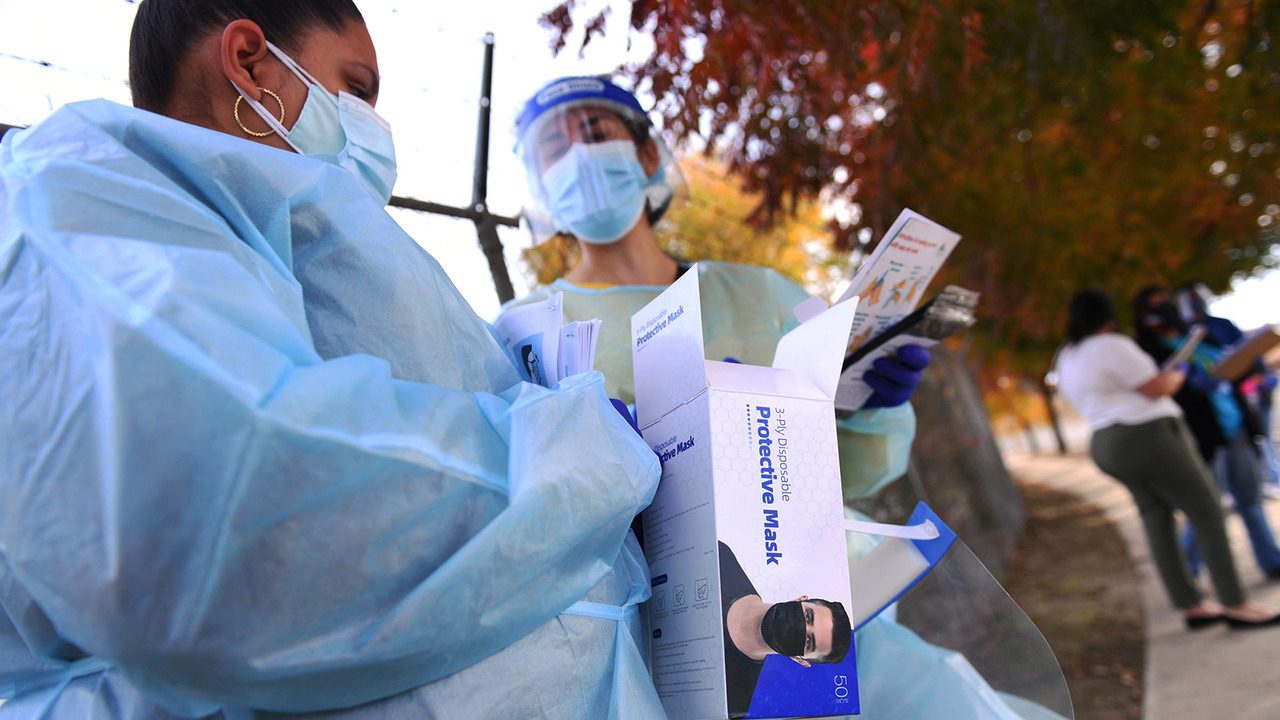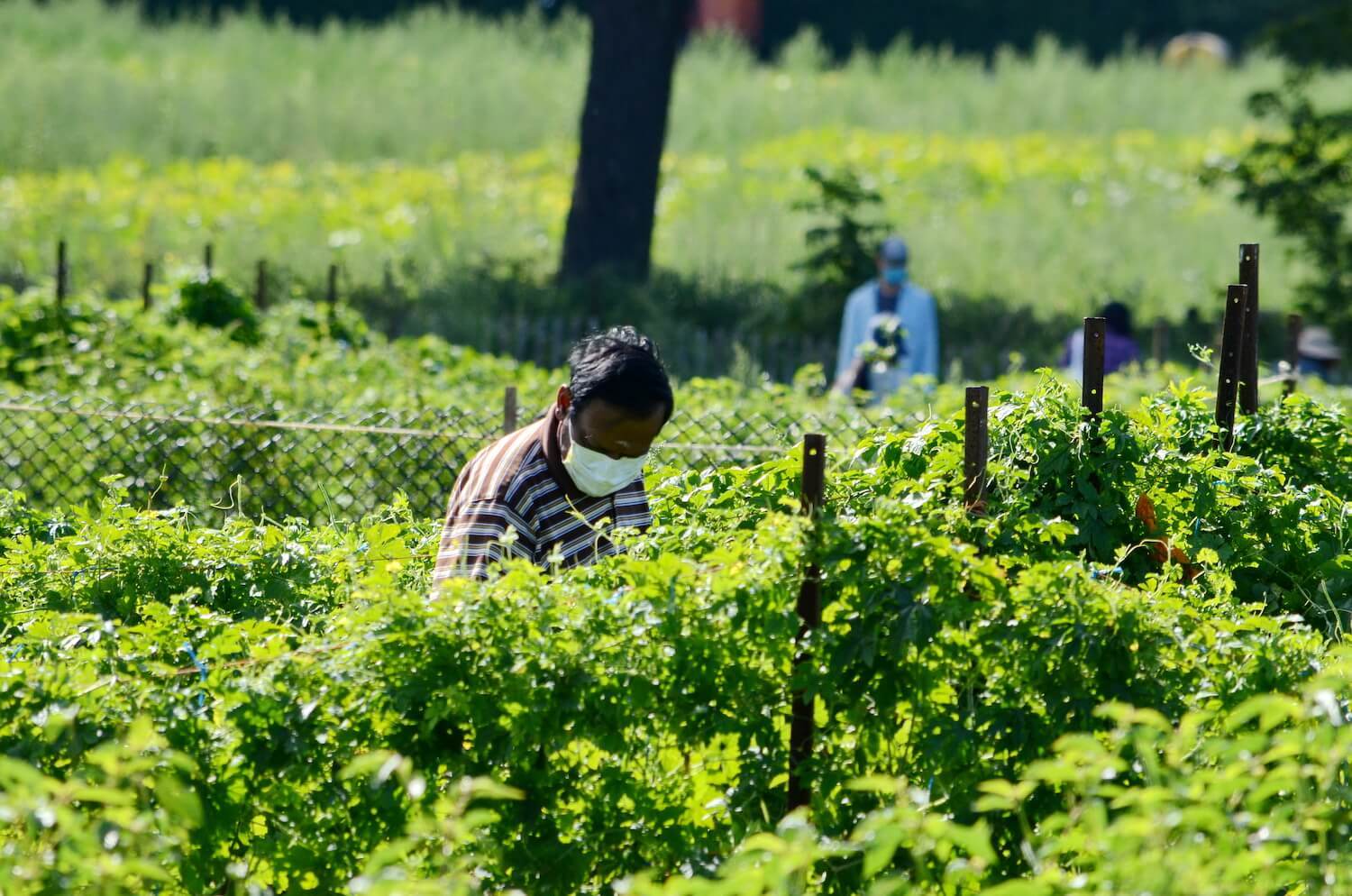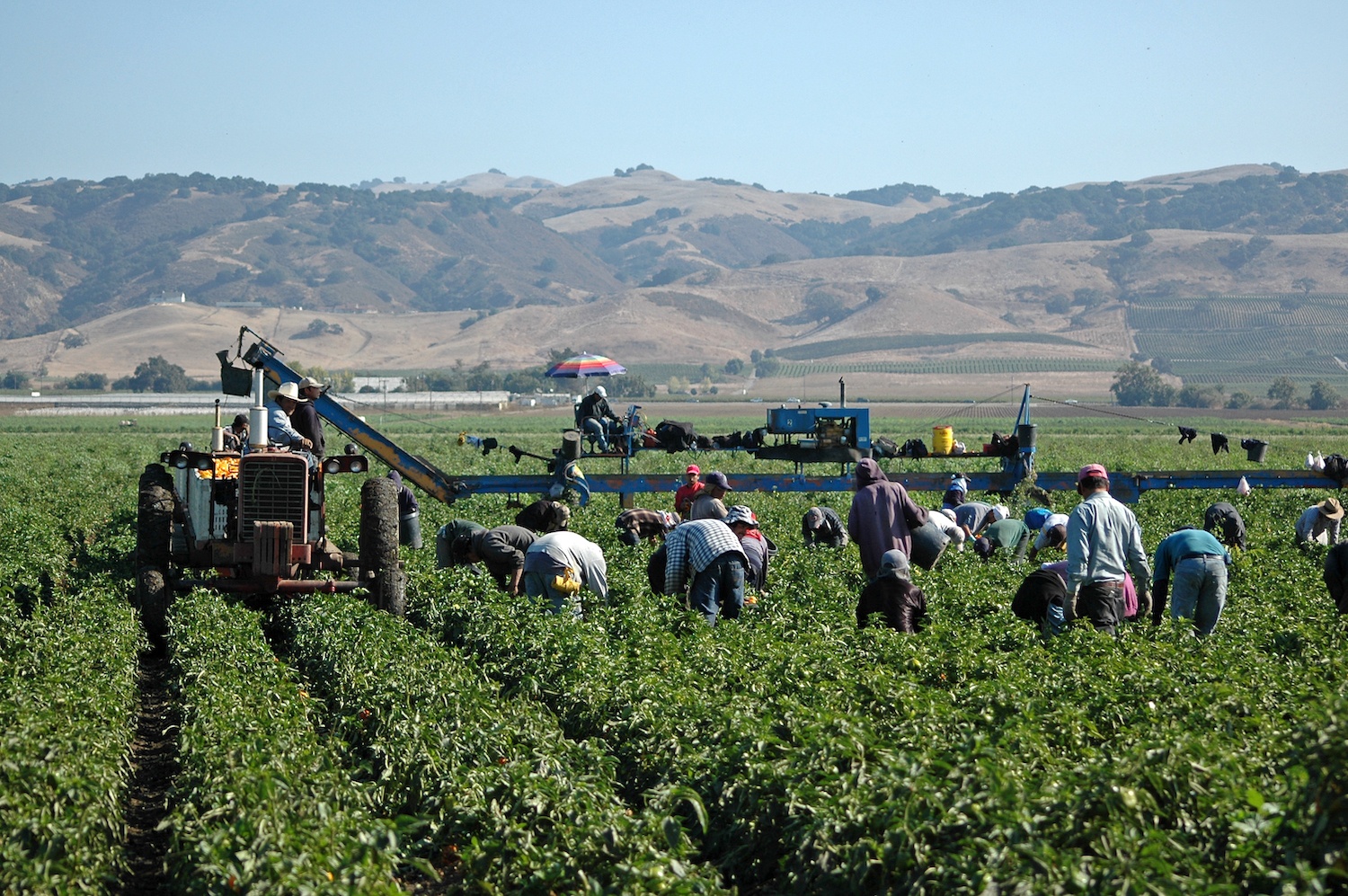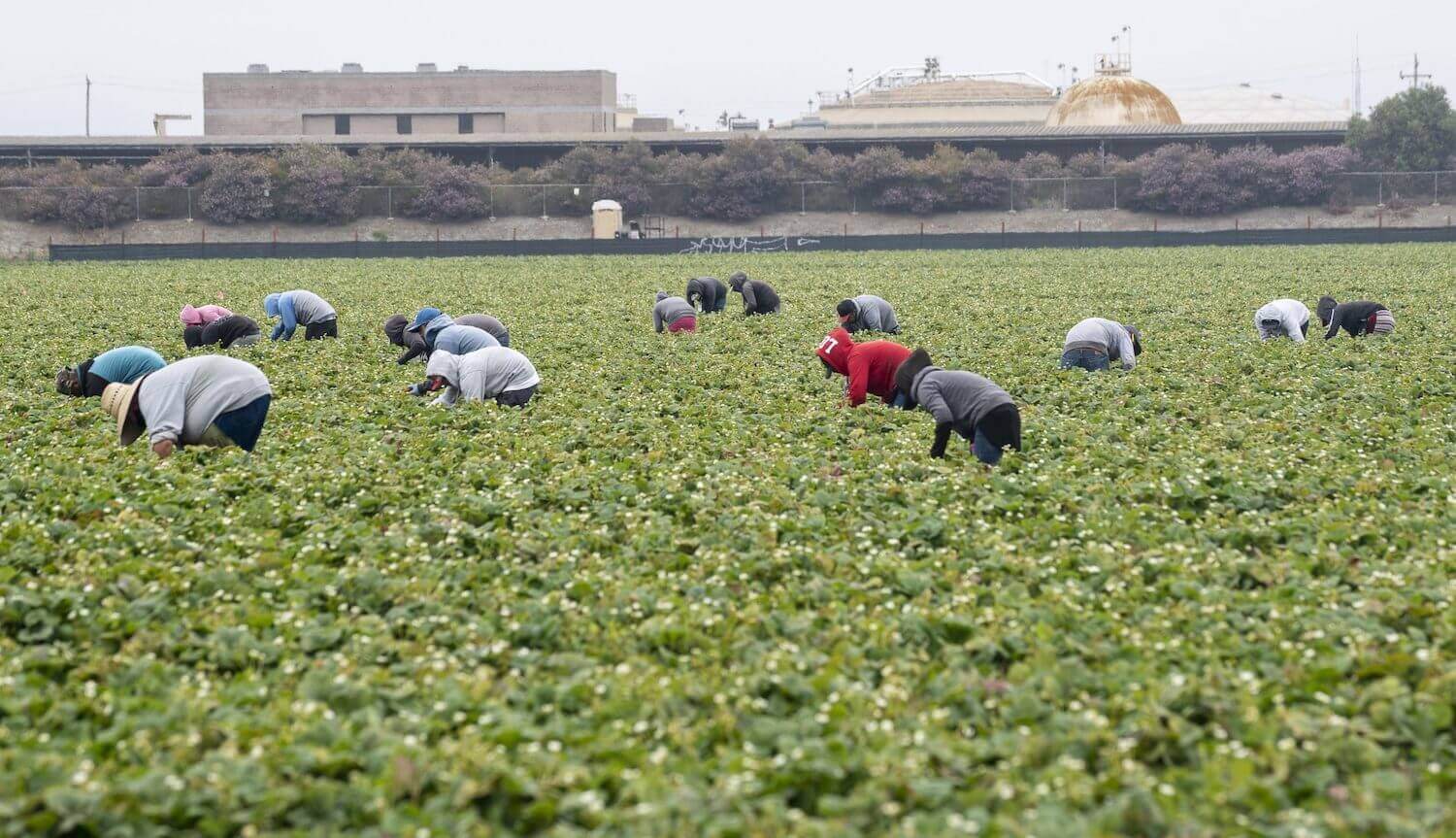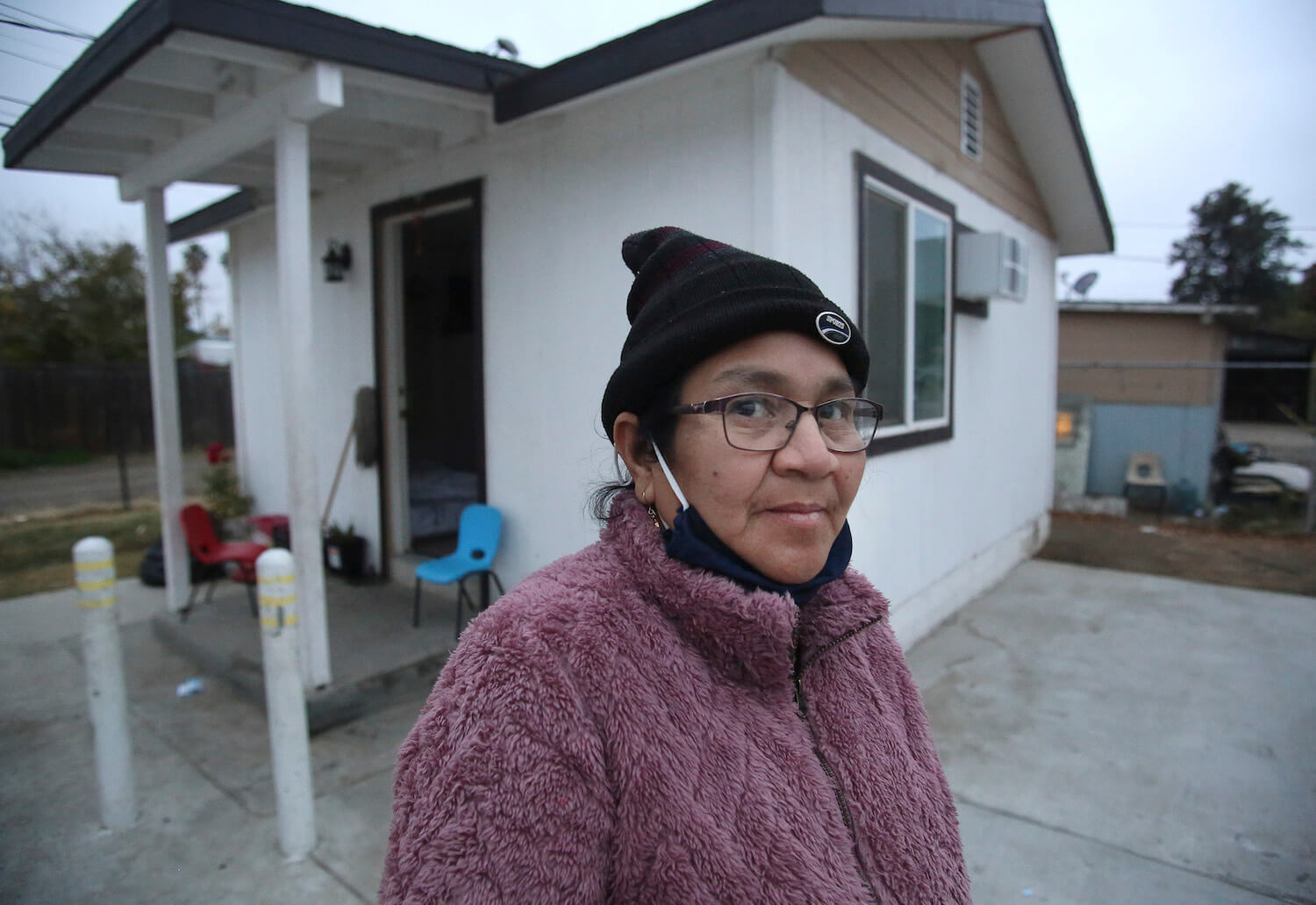
Gary Kazanjian
Despite the heavy toll of Covid-19 on California’s farm workers, Gavin Newsom’s pandemic housing program made just 81 hotel reservations for ag workers as of December 16.
In the first days of August, Fresno farm worker Brenda Yamileth, lined up for a Covid-19 test alongside her mother and brother. Feverish and headachy, she held her 10-month-old daughter. Soon, all four tested positive.
Pictured above: María Reyes, who tested positive for Covid-19, quarantines at her home in Mendota on Dec. 12, 2020. Reyes declined a hotel room with Housing for the Harvest out of concern she would have to leave her teenage daughter.
She quarantined with her baby in one bedroom of her Mendota house while her husband and 2½-year-old son slept in the other. Daughter Michelle cried nonstop, and Yamileth worried for the baby’s health. At the same time, she feared infecting her husband and son, steps away. Her husband developed a cough as she quarantined, but never got a test.
Quarantining at home wasn’t safe, Yamileth thought: “Creo que no era sana.”
This story originally appeared in CalMatters, an independent public interest journalism venture covering California state politics and government.
The virus has continued to wreak havoc on her life, resulting in a stroke months later.
Weeks after she was first diagnosed, Fresno County launched Gov. Gavin Newsom’s Housing for the Harvest, a program designed for farm workers such as Yamileth, who could not isolate or quarantine safely at home. The program provides hotel rooms to infected or exposed farm workers, and if it had been ready, Yamileth said, she would have taken it.
A joint investigation by the Documenting Covid-19 project at the Brown Institute, CalMatters and The Salinas Californian reveals just around 80 of the state’s over 800,000 farm workers have quarantined or isolated in hotel rooms for agricultural workers since the program was announced in July.
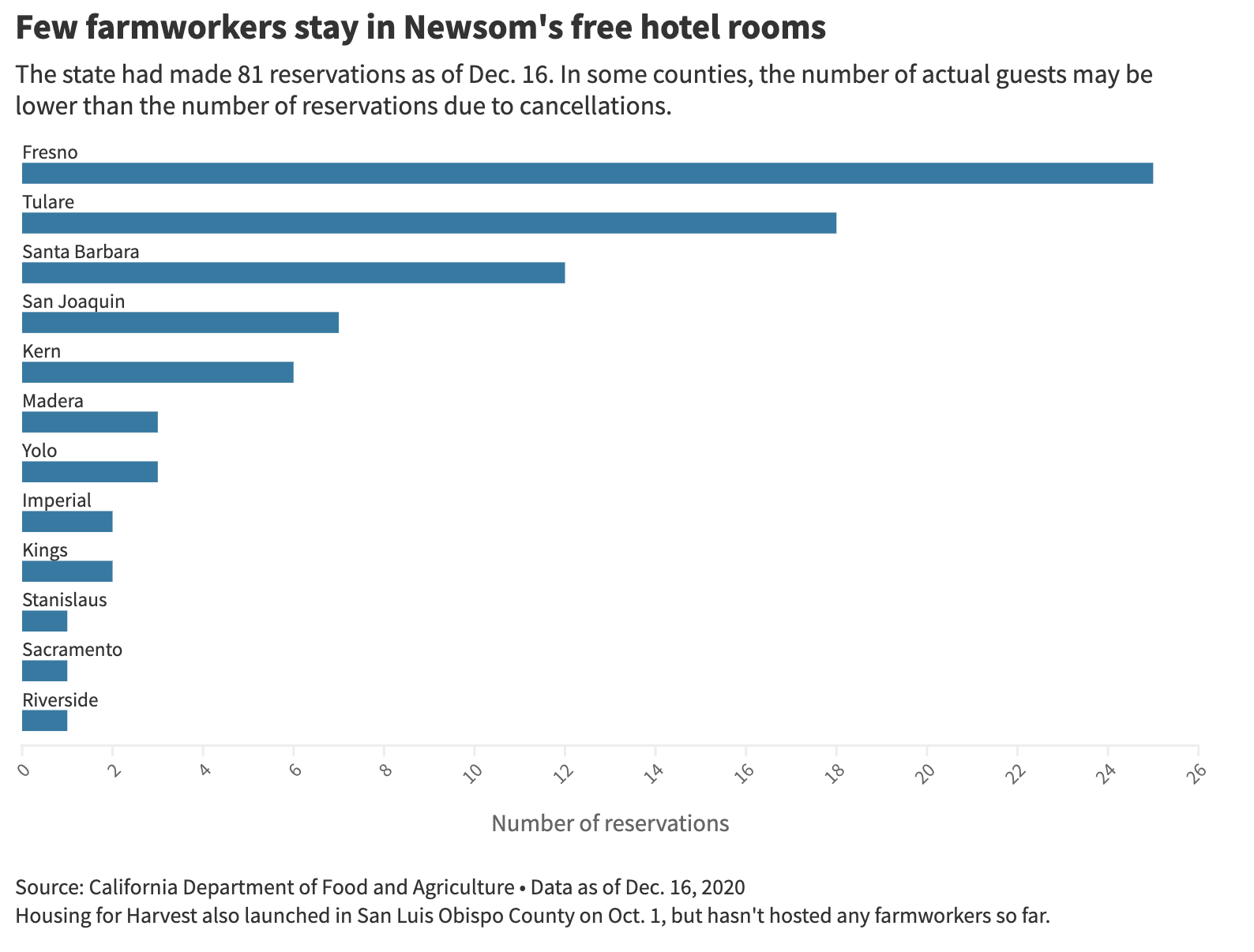
In interviews with nearly 20 farm workers, advocates and administrators, as well as a review of internal county emails obtained through record requests, reporters found a potent cocktail of fear, testing barriers and miscalculations have hobbled the statewide hotel isolation and quarantine program even as the virus spreads faster in California’s vast farm worker population than in the general public.
In that time, over 16,500 California farm workers have fallen ill from Covid-19, according to estimates by Purdue University.
‘Everything about it is a barrier’
Newsom announced Housing for the Harvest on July 24, calling for an “abundant mindset” to help these essential workers.
The governor was inspired by a relatively successful program that the Grower-Shipper Association of Central California mounted in Monterey County in April which has temporarily housed 401 farm workers and their dependents. It expanded to Yuma, Ariz. and the Imperial Valley in early November, housing another 50 between the two new sites.
It “likely limited the potential for large, cluster outbreaks,” said the association’s president, Chris Valadez, who cited the program’s lack of barriers as reason for its comparatively high number of guests.
One in eight of the county’s Covid-19 cases were agriculture workers, but Housing for the Harvest has made just 12 hotel reservations.
Grower-Shipper’s program was spurred by dire conditions among the region’s farm workers, many of whom live in overcrowded homes. Internal Monterey County emails from June showed workers didn’t have enough space to isolate and quarantine and some faced threat of eviction from their landlords. In a recent study of Salinas Valley farm workers, 43 percent of respondents said they had nowhere to isolate and one in five had contracted Covid-19 at some point, per antibody tests.
The need seemed self-evident across the state, too. About four in 10 Californians who live with an agricultural or food processing worker also live in an overcrowded home — defined as having more people than rooms — according to a CalMatters analysis of census data.
But the farmworking community has largely declined to use the state-sponsored housing. According to the California Department of Food and Agriculture, 81 rooms have been booked as of Dec. 16 across 12 counties. The program launched in San Luis Obispo County as well, but has not yet seen any guests. Reservation totals may be higher than the actual number of guests, though, as counties say some cancelled.
The state has spent around $75,000 as of Dec. 4, of which the federal government will reimburse 75% — on hotel reservations, while local governments cover food, protective equipment and staff training.
County and state officials, as well as advocates, say farm workers fear the hotel rooms open them up to job loss, deportation, problems with citizenship or residency cases, even the fear of battling a deadly disease alone.
“What comes to mind to a lot of people is family separation.”
Santa Barbara County’s Agricultural Commissioner Cathy Fisher was optimistic at the outset. In an August email to the county’s public health director, she wrote, “I think the program is going to be popular,” after attending a meeting in which state officials said they were in talks with six hotels in the county.
By late November, one in eight, or 1,300, of the county’s Covid-19 cases were agriculture workers, but Housing for the Harvest has made just 12 hotel reservations.
“Everything about it is a barrier,” said Lisa Valencia Sherratt, Santa Barbara’s Housing for the Harvest coordinator. It takes time to build a government-funded program that is culturally competent, she said.
Still, Housing for the Harvest organizers say farm workers are flocking to call centers, financial assistance and in-home isolation resources that counties and nonprofits have quickly scaffolded around the self-quarantining program, on their own dime.
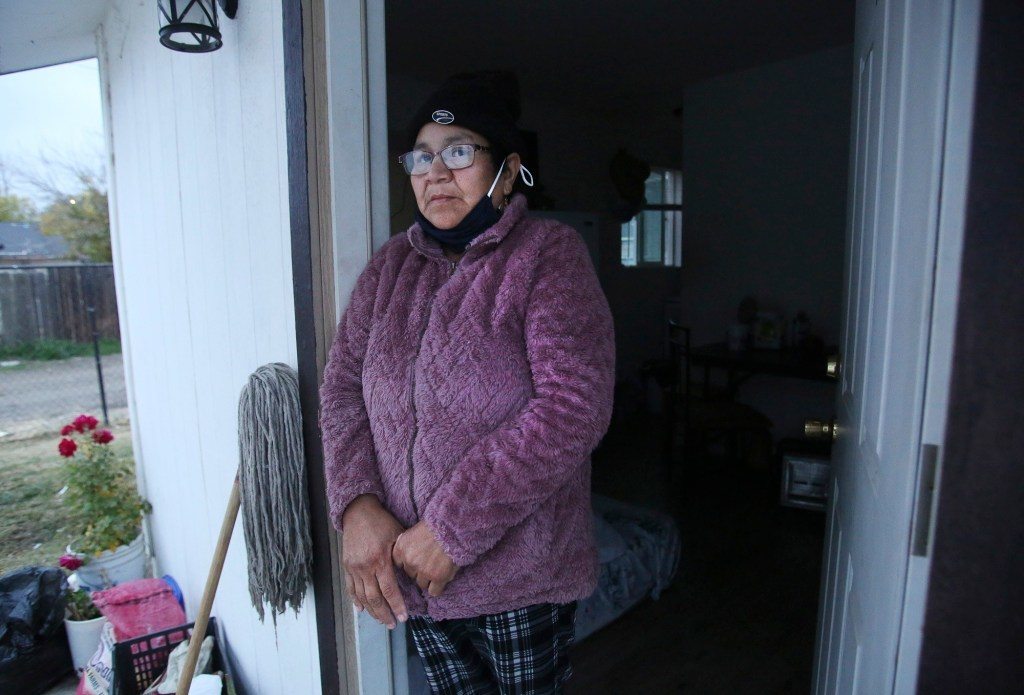
María Reyes has COVID-19 and is quarantining at her home in Mendota on Dec. 12, 2020.
Gary Kazanjian
María Reyes, a Mendota farm worker is currently isolating after testing positive in the one-room home she shares with her 16-year-old daughter.
She called Housing for the Harvest after seeing a television ad that promised help with rent and food. She was desperate: too sick to work, and unable to pay her bills or buy food.
She resisted taking a hotel room, though, worried about leaving her daughter, who tested negative, behind. She didn’t know that in some cases, Housing for the Harvest allows farm workers to bring their dependents.
Around the program’s launch, one Fresno administrator predicted their county’s program would host at least 1,000 farm workers in their hotel rooms. Instead, 15 have made reservations.
Serrano initially thought the program could help, but soon noticed every time he told families about the state-funded hotel rooms, “it was like a red light in their head.”
“What comes to mind to a lot of people is family separation,” said Fernando Serrano, who runs a food pantry for farm workers in Tulare County. The county has tracked more than 1,500 cases since July and 40 deaths among agricultural workers since the start of the pandemic, but has only made 18 reservations through Housing for the Harvest. Serrano initially thought the program could help, but soon noticed every time he told families about the state-funded hotel rooms, “it was like a red light in their head.”
Eleven days later, Reyes was still waiting for the promised $250 and groceries and no one had returned her calls, she said, her sentences broken by coughs. To make matters worse, her landlord had begun to press her for December’s rent.
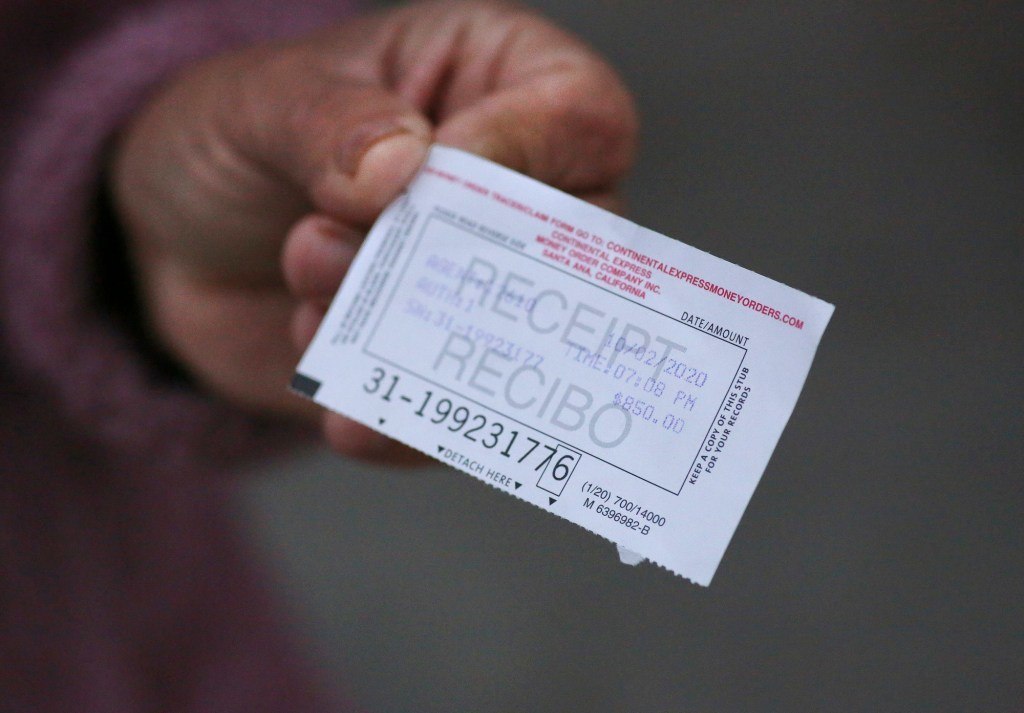
María Reyes holds a receipt from her Covid-19 test as she quarantines at her home in Mendota on Dec. 12, 2020.
Gary Kazanjian
A spokesperson for the Fresno organization that administers the hotel rooms said they refer people who decline hotels to another organization, which should contact them within 72 hours. It’s not clear if Reyes qualified.
Even as the program has fallen short so far of providing farm workers a safe place to isolate at scale, officials say that hotel stays are increasing, more than tripling over the last six weeks.
“This is about serving the needs of the individual, not about getting big, high numbers in a hotel room,” said CDFA Undersecretary Jenny Lester Moffitt.
For some, a hotel room is a lifeline.
In early November, 19-year-old Coachella Valley farm worker Fernando Perez isolated in his Chevrolet truck after he was diagnosed with Covid-19, rather than risk infecting his parents.
About 60 percent of California farm workers are undocumented. They are far less likely to be insured and often avoid healthcare.
For four days he parked the truck in different places, far from people. His family would leave broth and other food for him outside the vehicle; he retrieved it once they’d left. He slept, uncomfortably, in the cab.
“Estuvo feo,” he said of the experience. In English, it was awful. Soon, Perez enrolled in Housing for the Harvest.
To date, he’s the only person to isolate in Housing for the Harvest’s Riverside hotel. Program staff brought him three meals a day and a $2,000 check to cover lost wages.
Johns Hopkins Public Health Associate Professor Dr. Stefan Baral lauded California for providing the rooms given that crowded housing is “probably your best global predictor of Covid” transmission. But Baral, who has studied crowded housing and Covid-19 among Latinos, counseled that the success of the program going forward depended on administrators consulting farm workers to improve its design.
‘It comes down to trust’
Housing for the Harvest requires farm workers test positive or have a physician’s referral, required to get federal reimbursement for the hotel rooms. Those turn out to be formidable barriers.
In internal emails from the health departments of several counties, officials acknowledged difficulties and reluctance among farm workers to seek Covid-19 tests or visit the doctor.
About 60 percent of California farm workers are undocumented. They are far less likely to be insured and often avoid healthcare.
In May, Dr. Pedro Moreno of Alisal Health Center in Monterey County wrote that undocumented workers who had gone to the ER with Covid-19 symptoms were getting billed. The “word is getting out and cost (or perceived cost) is becoming a barrier to getting tested,” replied an attorney at California Rural Legal Assistance.
Symptomatic farm workers avoided testing because they needed to work or didn’t know their rights.
The lack of free testing is a “big issue,” wrote the environmental health specialist for Fresno County in a June email. But when the health department sent mobile testing units, few showed up. Symptomatic farm workers avoided testing because they needed to work or didn’t know their rights, a nonprofit executive wrote the county.
There’s also the issue of trust. In late July, CDFA Secretary Karen Ross met with agricultural commissioners of eight Central Valley counties and wrote that they told her “it will be important to message to farm workers that it is safe to do the isolation housing.”
Farmworker advocates say the state and counties have failed to get that message across.
Even though the program does not collect any personally identifying information and tracks guests using monickers only, Valencia Sherratt, the coordinator in Santa Barbara, said many farm workers fear “putting your name on a database of a government program.”
Often, she added, people worry it could lead to deportation or count against them if they apply for permanent residence under President Donald Trump’s controversial “public charge” rule. (The administration has amended the rule, which was recently paused in California by a federal court, to not include Covid-19 care.)
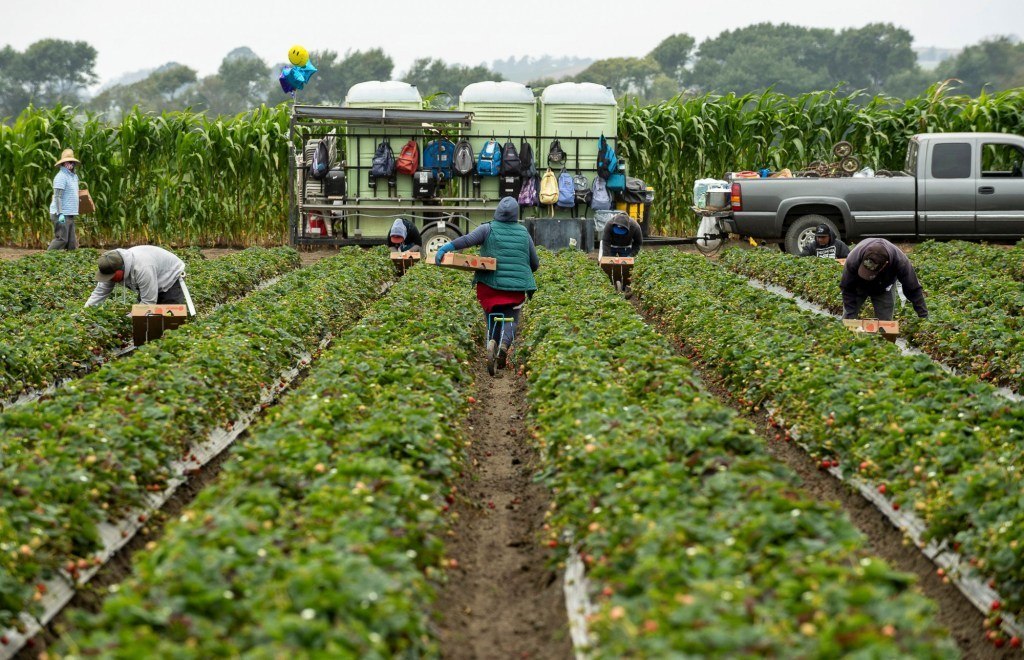
Many farmworkers are undocumented, often avoiding healthcare and government programs out of concern for their immigration status.
David Rodriguez, The Salinas Californian
United Farm Workers Secretary Treasurer Armando Elenes said in many cases county governments haven’t built the necessary relationships with farm workers. Farmworker advocates all over the state agreed and expressed frustration that they hadn’t been recruited to help design or promote the program.
Administrators, too, said Housing for the Harvest should have reached out through trusted partners earlier.
“It comes down to trust,” Elenes said.
Many farm workers fear “putting your name on a database of a government program.”
Tellingly, Housing for the Harvest fields more calls from farm workers seeking other types of assistance. The Central Valley call center receives between 500 and 1,200 calls each week, triaging questions about Covid-19, food and rental assistance, mental health services, and labor rights. In Riverside County, more than 250 have used a cash assistance program of up to $2,000 for farm workers — funded through the county’s CARES Act dollars — exhausting the funds.
So Serrano who runs the Tulare food pantry asked, why not give the state’s hotel funds directly to farm workers to replace their wages while they isolate at home?
Cash aid made all the difference for Edward Zarate, an agricultural truck driver in eastern Riverside County. When his entire family was exposed to Covid-19, they decided to isolate together at home. He broke down in tears when he received the full county-funded $2,000 stipend and 14 days’ worth of meals.
Zarate and his wife normally work seven days a week. It’s both a point of pride and necessary: combined, they made $52,000 last year. But this year, they’ve struggled.
He did not know about the program’s hotel rooms, but even if he had, he said, he wouldn’t have been interested. A few years ago, he and his wife stayed in a motel and came home with bed bugs.
The cash assistance meant they could both isolate and keep up with their bills.
“We’ve told everybody that we know about the program,” Zarate said. “Strangers, too.”
CalMatters’ Matt Levin, The Fresno Bee’s Manuela Tobias and The Desert Sun’s Rebecca Plevin contributed to this report. This article is part of the California Divide, a collaboration among newsrooms examining income inequality and economic survival in California.




